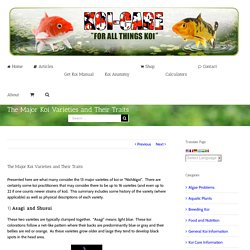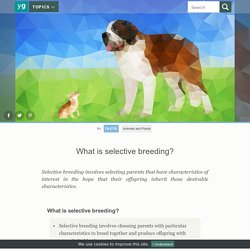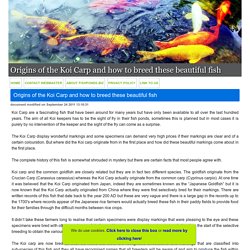

The Major Koi Varieties and Their Traits. Presented here are what many consider the 13 major varieties of koi or “Nishikigoi”.

There are certainly some koi practitioners that may consider there to be up to 16 varieties (and even up to 22 if one counts newer strains of koi). This summary includes some history of the variety (where applicable) as well as physical descriptions of each variety. 1) Asagi and Shusui These two varieties are typically clumped together. “Asagi” means light blue. Asagi 2) Bekko This variety was actually developed back in the early 1800’s and is recognized by their tortoise shell like pattern. Bekko 3) Hikarimoyo Mono Hikarimoyo translates into “metallic pattern”. Hikari-moyomono 4) Hikari Utsuri Mono This variety of koi are bi-color and have unmistakable metallic scales. Hikari Utsuri Mono 5) Kawari Mono Koi taking on this moniker often don’t readily fit into any other category very easily. Kawari Mono 6) Kinginrin Kinginrin 7) Kohaku Kohaku 8) Koromo Koromo 9) Ogon Ogon.
Koi. Commonly called Koi in the western world, and originating from the common carp, Cyprinus carpio, the name “Koi” comes from Japanese and simply means “carp”.

In reality the name Koi thus includes both the dull grey food fish as well as the brightly colored ornamental varieties. The correct name for the beautiful ornamental carp is Nishikigoi – a name that literally and very descriptively means “brocaded carp”. If you wish to become an afficionado of this fish, it would be wise to learn and use the correct term, as Nishikigoi were developed in Japan and the language of the koi world, or more correctly the Nishikigoi world, is and will remain Japanese.
Japanese is used not only to name the varieties, but also for many of the terms used to describe the colours and traits of these beautiful fish. As an aside, in Japanese koi is a homophone for another word that means “affection” or “love”; koi are, therefore, symbols of love and friendship in Japan. Nishikigoi , or Koi do not breed true! What is selective breeding? Selective breeding involves selecting parents that have characteristics of interest in the hope that their offspring inherit those desirable characteristics.

What is selective breeding? Selective breeding involves choosing parents with particular characteristics to breed together and produce offspring with more desirable characteristics. Humans have selectively bred plants and animals for thousands of years including: crop plants with better yields ornamental plants with particular flower shapes and colours farm animals that produce more, better quality meat or wool dogs with particular physiques and temperaments, suited to do jobs like herd sheep or collect pheasants. Selective breeding aims to adapt an organism’s characteristics in a way that is desirable to the humans that breed them. Humans have selectively bred apples to create lots of different varieties. How does selective breeding work? An organism’s characteristics are partly determined by the combination of gene variants? Send. Selective Breeding or Artificial Selection.
Artificial Selection is a form of selection in which humans actively choose which traits should be passed onto offspring.

Humans have used selective breeding long before Darwin's Postulates and the discovery of genetics. Farmers chose cattle with beneficial traits such as larger size or producing more milk, and made them breed; and although they may have known nothing about genes, they knew that the beneficial traits could be heritable. The farmers selected for certain traits in their cattle and probably noticed that the offspring were becoming more and more productive with each generation. Scientists study these traits and spend a lot of time calculating how heritable these traits can be. The more these traits are expressed in the offspring (i.e. size, milk production, etc), the more heritable these traits are said to be.
Here is an interesting article that outlines some of the advantages and disadvantages of artificial selection. Here's an example of selective breeding on a farm. Cats. Origins of the Koi Carp and how to breed these beautiful fish. Koi Carp are a fascinating fish that have been around for many years but have only been available to all over the last hundred years.

The aim of all Koi keepers has to be the sight of fry in their fish ponds, sometimes this is planned but in most cases it is purely by no intervention of the keeper and the sight of the fry can come as a surprise. The Koi Carp display wonderful markings and some specimens can demand very high prices if their markings are clear and of a certain colouration.
But where did the Koi carp originate from in the first place and how did these beautiful markings come about in the first place. The complete history of this fish is somewhat shrouded in mystery but there are certain facts that most people agree with. Koi carp and the common goldfish are closely related but they are in fact two different species. So how can I breed Koi Carp? How do I know if the fish are ready to spawn?